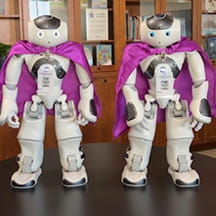Mark Moore has spent his life in the business of protection. Since serving in the United States Marine Corps for more than a decade, he has provided security services for business leaders and world events—from Bill Gates to the Olympic Games. His first foray into the health care industry came in 2018 when he joined Dayton Children’s Hospital in Ohio as corporate director of Protective and Support Services, where he’s charged with keeping 27 locations safe—from the main campus to clinics and all other locations dedicated to care.
His first order of business: approaching senior leaders about new ways of protecting staff, patients and families from violence in the hospital—specifically, shootings. He quickly gained approval from his leadership team to make a million-dollar investment in gunshot detection technology. Since that time, the need for such measures has only grown.
“The events of the world have created a sense of urgency,” says Moore. When COVID-19 turned the world on its head, the health care setting saw increased incidents of violence brought on primarily by higher levels of patient and family stress, frustrations due to mask and visitation policies, and staffing shortages. The vulnerability of health care facilities has been coming to new light over the last year, as staff have been injured or killed in shootings in the workplace across the country. On a single day back in June, four staff members were fatally shot in two different adult hospitals—one in Dayton, Ohio, and the other in Tulsa, Oklahoma, where the shooter blamed his surgeon for his back pain.
These and other shootings have raised concerns about the health care setting becoming more of a soft target, like schools—prompting new discussion and action on security approaches to keep patients, families and staff safe in both inpatient and outpatient settings. This is coming in many forms—from increased staff training and safety officer deployment to visitor management strategies and weapon detection systems. It’s placing children’s hospitals in a delicate balancing act: deploying the most effective safety and security measures without losing the warm, welcoming environment they’ve worked for years to create.
Detection tools
In the past year, the University of Vermont Children’s Hospital in Burlington has experienced an unprecedented surge in violence in its emergency department. “The number of assaults on staff members has increased significantly,” says Stephen Leffler, M.D., president and COO at Vermont Children’s. “The number of episodes where weapons are discovered on someone who’s made it into the ED or even an inpatient floor has gone from essentially zero to happening more than occasionally—and they are very scary.”
As part of a larger hospital system, the emergency department serves both adults and children. Adding metal detectors became a necessity for staff safety, even though Leffler and his team were concerned about the effect it would have on patients’ experience and perception. “Clearly, going through metal detectors is not what you’re hoping for in the entrance of your ED. It sets a certain potential tone,” he says. “But we decided that in the interest of the safety of everyone, this was the right thing to do. And it was a tough decision.”
Since installing the detectors a couple of months ago, violence has already decreased, Leffler says. And so far, patients are more accepting of them than he anticipated. “We haven’t had many complaints, and they’re grateful to know we’re thinking about their safety,” he says. This sentiment is in line with published research showing that most patients respond favorably to the presence of metal detectors in pediatric emergency departments, feeling safer.
Metal detectors come with other challenges, however. They require enough space to install and to allow for adequate traffic flow. They require capital to purchase and maintain, as well as cash flow to keep them staffed 24 hours a day by officers who are trained in using the equipment and in responding to visitors who refuse to give up their weapon. At Vermont Children’s, two security officers operate the detectors—a job which includes searching bags and escorting contraband to secure lockers before visitors are allowed into the ED.
One potential drawback of metal detectors in emergency departments is patients having to wait in long lines, Leffler says. Even if the weather isn’t an issue, someone waiting might have an urgent medical need. To solve that, Vermont Children’s has an EMT evaluating those in line to determine if someone needs triage or prioritization. “Although these drawbacks are not ideal, this is the best thing we can do to help keep our patients, families and staff as safe as we possibly can,” Leffler says.
Many of the drawbacks and limitations of metal detectors can be circumvented with newer detection technology. Children’s National in Washington, D.C., is piloting a touchless security screening system that combines metal detection and artificial intelligence to spot concealed weapons. Unlike traditional screening systems—like those in airports—a person can walk through this unobtrusive device without stopping, without removing anything from their pockets or bags, without taking off their jewelry or belts. “You’re looking to provide care to people quickly—so you want to get them into your building in the most convenient and safest way possible,” says Paul Quigley, executive director of security, parking and transportation at Children’s National.
They’re grateful to know we’re thinking about their safety.
The system will alarm when someone brings anything that is shaped like a weapon and will show the security team exactly where the potential weapon is located on that individual. “It shows a picture of the person and a region of the body or bag or cart they’re wheeling in,” he says. “But the alarm is not alerting on keys, cell phones or change in your pocket because of the advanced analytics. So, most people walking through it don’t get detected in any way.”
In addition to keeping all patients, families and staff—including security—safer, it keeps the line moving and the visitor experience positive. During a one-day demo in June, more than 1,000 people entered the hospital through this system, and 90% of them were never stopped. The security team was able to process the other 10% within five seconds each time, once the individual opened their jacket or bag, according to Quigley—and there was never a line of people waiting to enter the building.
“During our demo, it did what it was supposed to do,” Quigley says. “That is, making the staff feel comfortable because we’re screening everybody coming through—and the patients and families loved it too, because they were able to feel like the hospital was safe.” Additionally, the screening system can be branded, making the technology fit into the environment.
In the emergency department, Quigley’s team uses metal detection wands in behavioral health cases and “if there’s a fear that some harm is going to be done toward either a provider or the patient themselves,” he says, adding that families have always understood the need for the wands in such instances. “This is to keep your family member safe and our staff safe,” he says. “That’s the thing that ends up making people feel more comfortable being in our environment.”
In addition to x-ray machines and walk-through detection systems, other detection and prevention methods children’s hospitals have implemented include K-9 security dogs, video surveillance, and weapon detection systems that integrate with security cameras. Generally, detection tools are more common in emergency departments where violence most frequently occurs and traffic is high.
These tools focus on detecting guns and weapons before they enter the building, but Dayton Children’s has also installed technology that detects guns after they are fired inside the hospital. Originally developed by the U.S. Department of Energy, the technology reads the energy instead of the sound of the gunshot, which helps reduce false alarms. The system alerts first responders in seconds—and the sensors are so specific, they can detect what caliber gun was used in the shooting. And because they look like smoke detectors, they blend right in with the hospital environment.
Moore and his team collaborated with about 10 groups across the hospital to test and implement the technology—from senior leadership and facilities to IT and systems integration. “We ran the technology in a sandbox for 30 days,” he says. “We had to make sure it played nicely with our access control system, our video management system and our mass notification system before going live.” Along with this rollout came Crisis Prevention Institute (CPI) training for staff, including active shooter response classes.
Staff training
Nick Markham, assistant vice president of facilities, has been with Cook Children’s Health Care System in Fort Worth, Texas, for 19 years. While training staff to reduce risk in the case of a shooting or other act of violence has long been a priority, the team has upped its game in the face of the events of the past year.
“We can create videos, webinars and just-in-time training for any event that takes place,” Markham says, citing a 20-minute training video that was created for staff within one week of the Tulsa shooting. Ongoing safety and security training covers situational awareness, de-escalation strategies and active criminal event response. The training, while not required, is available to all staff—and features active shooter drills where the instructor wears a body camera to simulate a shooting.
“He’s in the active shooter role, and he shows people what happens should a person enter the building and how quickly the escalation takes place,” says Markham. “So, he shows how people gain access to the back of house or the back of a clinic; how they try to get through a locked door; how easy it is to jump a reception desk—those types of things.” Then, he teaches staff about Avoid, Deny and Defend, meaning how to run, how to barricade yourself or how to fight back when faced with an incident.
Public safety officers
Both Cook Children’s and Dayton Children’s employ uniformed, armed public safety officers. Neither sees them as the traditional “officer” but rather an integral part of the hospital family and patient care.
“The officer should not be an opposing figure. This should be someone who’s protective, nurturing and offering assistance,” says Markham. Public safety officers at Cook Children’s are licensed police officers in the state of Texas, with compassion as part of their training.
“You have no idea what a person is going through—families are in a very hard place when they’re here with a sick child,” Markham says. “Our officers understand that. There’s a huge compassion component when you’re an officer.”
Another huge component is the connection with patients. The personification of that is Officer Louis White. “Everybody knows Officer Louis,” says Markham. “He is everywhere. He’s at orientation, he interacts with patients on our rehab unit—he is part of the care team that goes to that unit and does music therapy with the kids. So, we have folks ingrained into the organization in ways that go far beyond the role of a security officer.”
The officer should be someone who’s protective, nurturing and offering assistance.
At Dayton Children’s, special care is taken when it comes to the role of behavioral health officers. They wear a different uniform in behavioral health units and don’t look the usual part of a public safety officer, which can help keep situations from escalating, Moore says. “They are still very clearly Dayton Children’s public safety officers, but they have none of what you would consider the tools of policing,” he says. “No handcuffs, no baton, no Taser, no pepper spray—they even have cloth Velcro badges.”
Across the board, children’s hospitals are reevaluating their approach to public safety officers, asking how many to deploy, what level of weaponry to carry, and what kind of protection to wear. Some officers carry pepper spray, others firearms; some wear ballistic vests, others plain clothes. Many hospitals, including Children’s National, hire off-duty law enforcement, who are armed, in addition to staff security. These officers enforce compliance during high-threat situations, deal with weapon-related incidents, and aid in arrests when necessary, says Quigley.
Managing visitors
While much of the work being done is focused on those who may be entering a facility with bad intent, the pressures are higher than ever to manage those who are supposed to be there—including families and other visitors. At the same time, children’s hospitals have always been built to be accessible—where staff can move patients easily and families can visit their children quickly and conveniently.
To help satisfy the need for safety and mobility, Cook Children’s uses an extensive network of cameras throughout the hospital. The cameras monitor visitors and all other activity in the hospital—as well as panic buttons in strategic places, like nurse stations and areas with a psychiatric component, to help minimize risk around potential events involving visitors.
At Children’s National, the team at the welcome desk checks all visitors against a robust database, ensuring all personnel, vendors and patient visitors are authorized to be there and pose no known threat. They also work closely with the staff upstairs in the care units to help determine which visitors—and how many—should be in a patient’s room at any time.
Because of the pandemic, Vermont Children’s reduced its number of visitor entrances to three, including the emergency department, to screen for COVID-19, and they decided to keep the limited number of entry points to better monitor visitors. Most floor entrances are locked as well, including the pediatric and mother-babies areas. They would like to implement strict visitor policies and management tools, but as with other security initiatives, staffing remains an obstacle.
Social workers
The Social Work Interventions with Families and Teams (SWIFT) program at Children’s National is designed to protect the frontline care team from incidents with patients and families inside the hospital while also ensuring those patients and families feel heard and supported. Verbal escalation, threatening behavior, physical aggression or impeding care on the part of a parent or other visitor often stem from the stress of having a sick or injured child in the hospital and being unable to communicate properly, says Brenda Shepherd-Vernon, director of the Department of Family Services at Children’s National Hospital. With SWIFT, social workers help mitigate such incidents to make staff feel safe, make families feel heard, and, ultimately, keep those families at the child’s bedside when possible.
“As social workers, we’re going to be impartial and look at what happened during the encounter—and we’ll work with the family and the team to resolve it,” Shepherd-Vernon says.
“In the past, the model dictated that security would be called if a parent was upset. Now, we’re trying to hear more about the families’ concerns and deal with those concerns in real time.”
Still, security is a close partner in SWIFT, along with a committee that reviews all cases of individuals who are asked to leave the premises due to aggressive behavior. The team also shares the expectations of conduct with the families to build a shared understanding and help prevent further incidents. There is also a huddle with the care team after an incident to discuss the concerns of the family and how to best address them going forward, as well as the resolution shared with the family and the plan to keep the staff safe.
Like none other
Leffler is part of a multi-sector collaborative that is seeking broader solutions to target the root causes of violence before it ever makes it to the children’s hospital. “What we’re seeing is just a piece of what is happening everywhere right now,” he says. “We want to come up with some recommendations to try and think about this problem in a bigger way than only once they arrive at the door of the hospital.”
For Moore’s part, protecting people, property and assets from harm has been at his core for the better part of 35 years. But he’s found that the children’s hospital setting is a world unto itself—one where keeping everyone safe physically, mentally and emotionally is paramount and constant.
“When I was running a protection team in my previous life, there were ebbs and flows,” he says. “We would ramp up to go on round-the-world trips with our protectees, working 16 to 18 hours a day—then we’d come home, catch our breath and ramp up for the next big thing. Here, the pace of the hospital is relentless. It never stops, it never closes. And everybody here wants to make the place better.”



